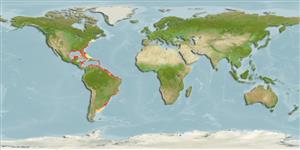Common names from other countries
Environment: milieu / climate zone / depth range / distribution range
ນິເວດວິທະຍາ
ສັດທະເລ; ນ້ຳກ່ອຍ ອາໄສຢູ່ໃກ້ໜ້າດິນໃຕ້ພື້ນທ້ອງນ້ຳ; ລະດັບຄວາມເລິກ 1 - 53 m (Ref. 9710). Subtropical; 46°N - 45°S, 98°W - 33°W
Western Atlantic: Canada (Ref. 5951) to Maine to Florida, USA (possibly from Nova Scotia, Canada), along coasts of central and south America (Ref. 26938) to Uruguay, including Bermuda and Gulf of Mexico (Ref. 9626). Rare in Greater Antilles (Ref. 26938).
ຂະໜາດ / ນ້ຳໜັກ / Age
Maturity: Lm ? range ? - ? cm
Max length : 48.3 cm TL ຕົວຜູ້/ບໍ່ມີເພດ; (Ref. 9626); common length : 35.0 cm TL ຕົວຜູ້/ບໍ່ມີເພດ; (Ref. 5217); ນ້ຳໜັກສູງສຸດທີ່ເຄຍຈັດພີມມາ: 2.1 kg (Ref. 40637)
ຄີ (ໜາມ)ແຂງຢູ່ຫຼັງປາ (ທັງໝົດ): 9; ຄີຫຼັງຂອງປາ (ຄີອ່ອນ) (ທັງໝົດ): 23; ຄີ(ໜາມ) ແຂງຢູ່ຄີກົ້ນປາ
ກຸ່ມປາກະດູກແຂງ
ຄວາມຖີ່ຂອງກຸ່ມຖ່າຍທອດພັນ
ປາທີ່ມີການເຄື່ອນຍ້າຍຈາກທະເລໄປຫານ້ຳຈືດ ແລະນ້ຳຈືດຫາທະເລ
ປາທີ່ມີການເຄື່ອນຍ້າຍຈາກທະເລແລະໄປໄຂ່ຢູ່ນ້ຳຈືດ
ຄີກົ້ນຂອງປາ
ສັດທີ່ມີກະດູກສັນຫັຼງ
ການຖ່າຍທອດທາງກຳມະພັນຈາກພໍ່ແມ່ຫາລູກ 3; ຄີກົ້ນຂອງປາ: 18. Pelvic fin small.
Adults are found in shallow coastal waters, usually over hard or sandy bottoms. Juveniles may be encountered in estuarine areas (Ref. 9626) and off sandy beaches (Ref. 5217). Found in schools, but may be encountered in small groups or in pairs (Ref. 26235). Adults feed on small crabs, shrimps, fishes, and worms. Flesh has excellent flavor (Ref. 5521). Marketed fresh (Ref. 9710).
Life cycle and mating behavior
ການຈະເລີນເຕັມໄວ | ການສືບພັນ | ການວາງໄຂ່ | ໄຂ່ | ຄວາມດົກຂອງໄຂ່ປາ | ຕົວອ່ອນ
Robins, C.R. and G.C. Ray, 1986. A field guide to Atlantic coast fishes of North America. Houghton Mifflin Company, Boston, U.S.A. 354 p. (Ref. 7251)
IUCN Red List Status (Ref. 130435)
CITES (Ref. 128078)
Not Evaluated
Threat to humans
Reports of ciguatera poisoning (Ref. 30911)
Human uses
Can't connect to MySQL database (fbapp). Errorcode: Too many connections
